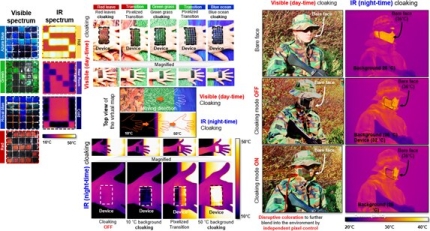Department News
[Chosun Ilbo] Prof. Seung Hwan Ko: Invisibility is Possible! Electric Skin Undetectable in Daylight
Author
관리자
Date
2020-11-11
Views
591
Invisibility is Possible! Electric Skin Undetectable in Daylight
Multiple Uses in the Defense Industry

The electric camouflage skin changes its color according to the surrounding environment during the day. At night, its temperature can be controlled to match the external temperature./SNU
A Korean research team has developed an ‘invisible suit’ technology that we have seen in science fiction movies.
On November 10th, Professor Seung Hwan Ko of the SNU Dept. of Mechanical Engineering and his team announced that they developed “electric skin that remains undetectable in visible light and infrared spectrums.” The research was published the July issue of Advanced Functional Materials.
◇Inspired by squids and octopuses disguising themselves
In nature, some animals actively disguise themselves in accordance with their surrounding environment to flee from predators and lure in preys, increasing their chances of survival. Cephalopods such as squids and octopuses are such an example. The nanometers of pigment particles in the skin of cephalopods can be rearranged in order to reflect the light in visible and infrared spectrums, offering a perfect disguise.
Prof. Ko’s research team took inspiration from this camouflage technique. The research team developed soft, flexible thermoelectric devices that can be attached to the skin. Thermoelectric devices can either absorb or emit heat according to the direction of the electric current. The devices can be cooled down or heated up at a quick speed, remaining invisible in the infrared spectrum, undetectable to thermal imaging cameras. In addition, ‘thermochromic liquid crystal ink,’ which changes color according to the temperature, was applied top of the devices so that they can shift color.
◇Camouflage is possible in both day and night
The research team developed a way to change the surface temperature and color of the thermoelectric devices in visible to infrared spectrum. It means camouflage is possible during both day and night.
Moreover, the team ‘pixelated’ the surface of the camouflage skin, so that certain pixels can be heated or cooled down. These thermoelectric pixels can be operated individually to receive data like displays do, and can quickly change in real-time even when surrounded by complicated patterns in visible to infrared spectrum.
On November 10th, Professor Seung Hwan Ko of the SNU Dept. of Mechanical Engineering and his team announced that they developed “electric skin that remains undetectable in visible light and infrared spectrums.” The research was published the July issue of Advanced Functional Materials.
◇Inspired by squids and octopuses disguising themselves
In nature, some animals actively disguise themselves in accordance with their surrounding environment to flee from predators and lure in preys, increasing their chances of survival. Cephalopods such as squids and octopuses are such an example. The nanometers of pigment particles in the skin of cephalopods can be rearranged in order to reflect the light in visible and infrared spectrums, offering a perfect disguise.
Prof. Ko’s research team took inspiration from this camouflage technique. The research team developed soft, flexible thermoelectric devices that can be attached to the skin. Thermoelectric devices can either absorb or emit heat according to the direction of the electric current. The devices can be cooled down or heated up at a quick speed, remaining invisible in the infrared spectrum, undetectable to thermal imaging cameras. In addition, ‘thermochromic liquid crystal ink,’ which changes color according to the temperature, was applied top of the devices so that they can shift color.
◇Camouflage is possible in both day and night
The research team developed a way to change the surface temperature and color of the thermoelectric devices in visible to infrared spectrum. It means camouflage is possible during both day and night.
Moreover, the team ‘pixelated’ the surface of the camouflage skin, so that certain pixels can be heated or cooled down. These thermoelectric pixels can be operated individually to receive data like displays do, and can quickly change in real-time even when surrounded by complicated patterns in visible to infrared spectrum.

The camouflage skin is ‘pixelated’ so that each pixel can change according to the environment. Camouflage is possible even when surrounded by complicated patterns or changing locations./SNU
The electric camouflage skin has multiple uses in the defense industry. The research team demonstrated its functions themselves by attaching it to actual skin, showing that it operates well in changing temperatures and complex woodland patterns.
“Camouflage technology is crucial in the military, protecting our soldiers against enemy attacks. We hope this research contributes to the Korean defense industry,” said Prof. Ko.
“Camouflage technology is crucial in the military, protecting our soldiers against enemy attacks. We hope this research contributes to the Korean defense industry,” said Prof. Ko.
[Ji-han Yoo jhyoo@chosun.com]
Original article : https://n.news.naver.com/article/023/0003575038

